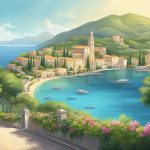Cycling through the Mediterranean countryside offers a serene and invigorating experience for enthusiasts and novices alike. The region’s diverse landscapes provide a perfect backdrop for this popular activity, mixing physical challenges with breathtaking scenery. Whether meandering along coastal paths, with the Mediterranean Sea’s azure waters as a constant companion, or pushing through rolling hills that offer panoramic views of lush vineyards and olive groves, cyclists are treated to an unparalleled sensory experience. The Mediterranean’s mild climate adds to the allure, allowing for year-round adventures on two wheels.
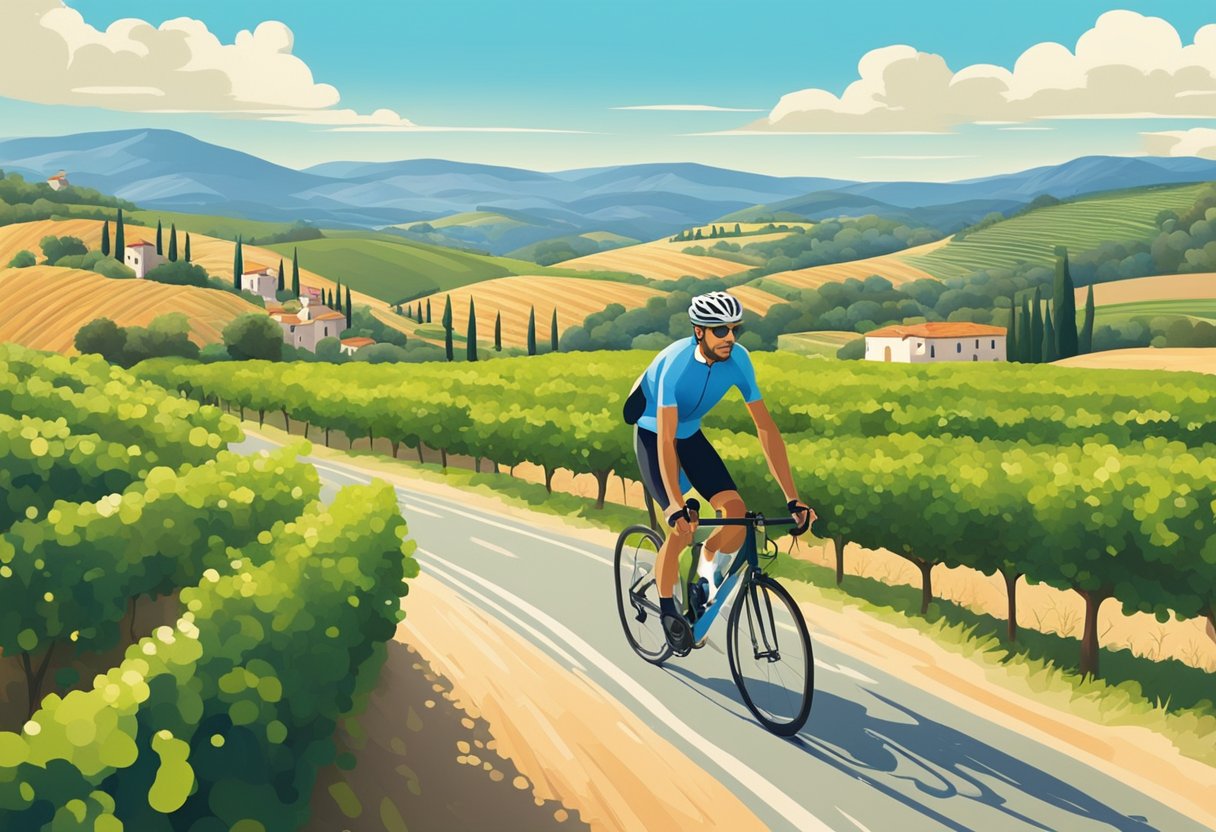
Beyond the physical journey, cycling in the Mediterranean is an immersion into the area’s rich history and culture. Riders have the opportunity to visit ancient towns, historical landmarks, and explore the varied culinary delights of the region—often incorporating the principles of a gluten-free diet abundant in local produce and traditional preparations. By approaching each journey with sustainability in mind, cyclists not only enjoy but also contribute to the preservation of the Mediterranean’s natural beauty and heritage.
Key Takeaways
- Cyclists in the Mediterranean experience diverse scenery and a favorable climate.
- Historical and cultural immersion is a significant aspect of the cycling journey.
- Embracing sustainability enhances the cycling experience and conserves the region.
Table of Contents
The Allure of Mediterranean Cycling
Cycling in the Mediterranean region offers a profound connectivity to its splendid vistas, storied past, and lively culture. Travelers on two wheels are treated to a sensory-rich journey through Italy’s diverse landscapes and the broader Mediterranean tapestry of art, history, and UNESCO World Heritage sites.
The Beauty of the Landscape
The Mediterranean countryside unfolds in a symphony of rolling hills, olive groves, and vineyards, particularly in regions like Tuscany. Cyclists encounter a terrain that is both a challenge and a delight, with the promise of Italy’s rugged coastlines and serene rural scenes punctuating their journey. Each pedal stroke offers a new perspective on Italy’s natural splendor, often encompassing the Mediterranean’s vivid blue waters as a stunning backdrop.
Cultural Immersion Through Cycling
On their routes, cyclists experience a cultural immersion that is as compelling as the landscape. Italy’s rich tapestry of art and history is displayed in medieval towns and Renaissance cities, where each turn can reveal an open-air museum or a UNESCO World Heritage site. The fabric of Italian culture is also woven into the experience, with opportunities to engage in the Mediterranean’s celebrated culinary arts, embracing a gluten-free twist to traditional dishes, and reveling in a culture that holds a deep appreciation for both history and modernity.
Iconic Cycling Destinations in the Mediterranean
Cycling enthusiasts are drawn to the Mediterranean for its unique combination of picturesque landscapes, cultural wealth, and varied riding experiences.
Italy’s Breathtaking Regions
Italy offers cyclists a captivating mix of historical architecture and lush landscapes. Tuscany is renowned for its rolling hills dotted with vineyards, olive groves, and medieval towns like Florence. The less-traveled regions such as Umbria provide serene paths, while the Dolomites boast challenging routes with dramatic mountain backdrops. Puglia’s coastal roads lead to the Trulli houses of Alberobello, showcasing Italy’s diverse scenic beauty.
Exploring Croatia’s Adriatic Charm
Croatia’s coastline presents a breathtaking cycling journey along the Adriatic Sea. The city of Split highlights a balance of contemporary life and ancient history, perfect for cyclists who appreciate cultural immersion. Further south, Dubrovnik—famous for its distinctive Old Town—provides a stunning setting for riding along the Dalmatian Coast, with routes for all experience levels.
The Diverse Terrains of Spain
Spain’s diverse landscapes cater to every cyclist’s preference. From the sun-kissed coastal routes to the challenging mountain terrain, places like the Sierra Nevada appeal to the adventurous. The country’s vibrant cities, such as Barcelona, are gateways to exploring the countryside and coastal trails. For those seeking a more tranquil ride, the rural areas around Bari and the Portuguese border offer scenic vistas and historically rich surroundings.
Greece and Albania: Ancient Routes Revisited
Cyclists in Greece can follow routes that trace the history of Western civilization. Pedaling through the Peloponnese reveals ancient ruins amid striking landscapes. Across the border in Albania, riders discover a country with a rugged appeal and a growing network of cycling paths. Both countries offer a window into the Mediterranean’s past, framed by majestic views and inviting coastlines.
Planning Your Mediterranean Cycling Tour
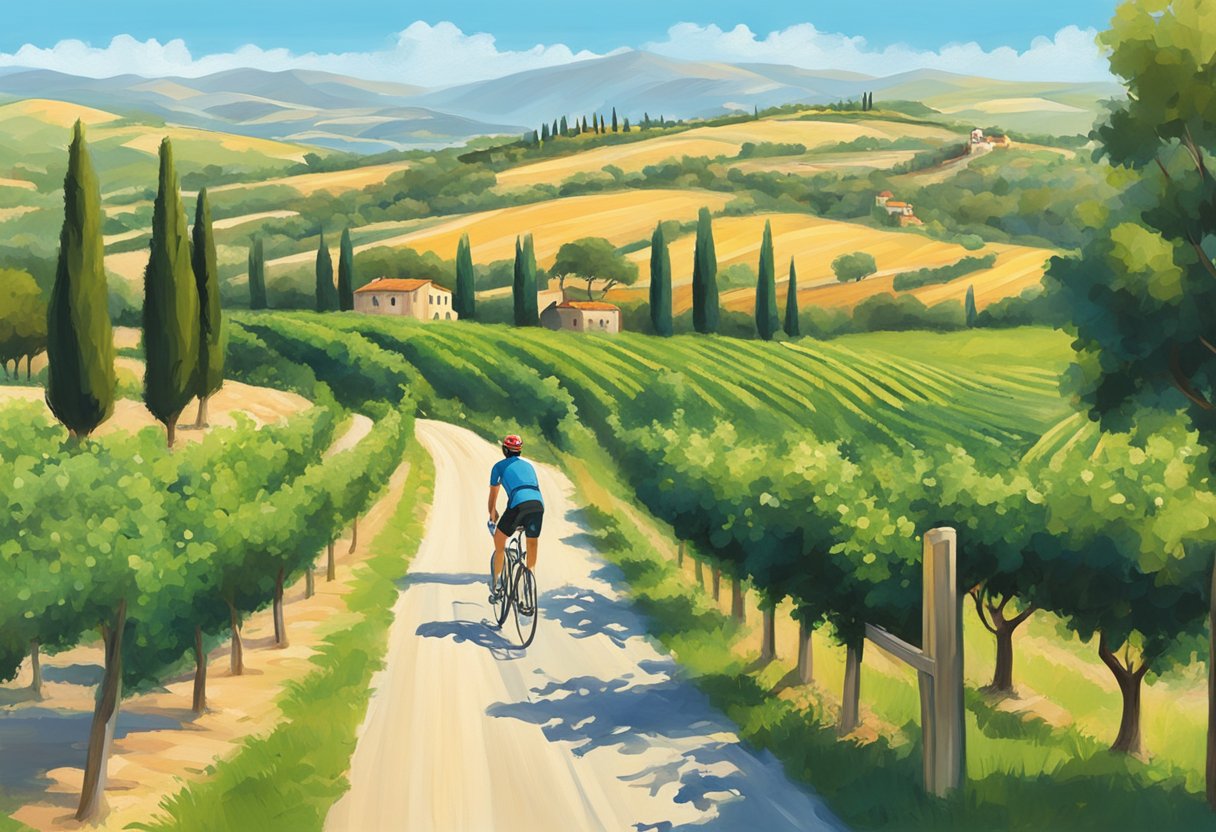
Embarking on a Mediterranean cycling tour is an engaging way to explore the region’s diverse landscapes, from serene vineyards to the shimmering coastlines of the Mediterranean Sea.
Selecting the Right Tour for You
When planning a cycling tour in the Mediterranean, travelers have a variety of options to choose from. Road cycling enthusiasts might prefer tours that incorporate long stretches along the coast, offering challenging rides and breathtaking sea views. Cycle Tuscany to immerse yourself in a world of rolling hills, where one can savor the scent of olive oil and vineyards. For those who are gluten-sensitive or gluten-intolerant, many tours offer opportunities to enjoy gluten-free Mediterranean cuisine, ensuring a worry-free experience.
Navigating Through Countryside Itineraries
A well-planned itinerary is crucial for a seamless cycling experience. Cyclists should seek out itineraries that include visits to local producers of olive oil and vineyards, coupled with tailor-made experiences to fit gluten-free needs. For a memorable adventure, consider adding a bicycle tour to your bucket list that meanders through the countryside, offering both guided and self-guided options for varying skill levels. Additionally, some cycling tours may complement your journey with options for walking tours, allowing for a slower pace to fully absorb the countryside charm.
Challenges and Rewards of Countryside Cycling
Countryside cycling through the Mediterranean region offers riders a symphony of experiences, from the arduous yet rewarding climbs to the serendipitous discovery of local gems. Cyclists are often enticed by the stunning vistas and the cultural immersion that comes with traversing rural landscapes on two wheels.
Thrilling Climbs and Passes
The Mediterranean terrain is synonymous with its thrilling climbs and mountain passes. Cyclists often encounter routes such as the famed Passo dello Stelvio, which presents both a challenge and a reward. The Adriatic coastline and the rolling hills of Tuscany provide gradients that are sure to test one’s endurance and skill. The effort invested in scaling these peaks is repaid with breathtaking views and the triumphant sense of achievement.
- Climbs: Steep gradients and alternating terrains.
- Mountain Passes: High elevations, celebrated in many European cycling events.
Discovering Hidden Gems Along the Way
A cyclist in the Mediterranean countryside is not just an athlete; they are an explorer. Rides often reveal hidden gems such as secluded hamlets, ancient ruins, and rustic vineyards. These discoveries are the unsung rewards of countryside cycling, offering cultural richness that goes beyond the physical aspects of the journey.
- Hidden Gems: Ancient architecture, local cuisine, untouched nature.
- Cultural Immersion: Intimate experiences with local traditions and history.
For individuals yearning for a personal challenge without the companionship cost, single supplements in cycling tours allow them the liberty to immerse themselves fully. Moreover, numerous cycling events throughout the region cater to every level of expertise, from novices to seasoned veterans.
Cycling Through History
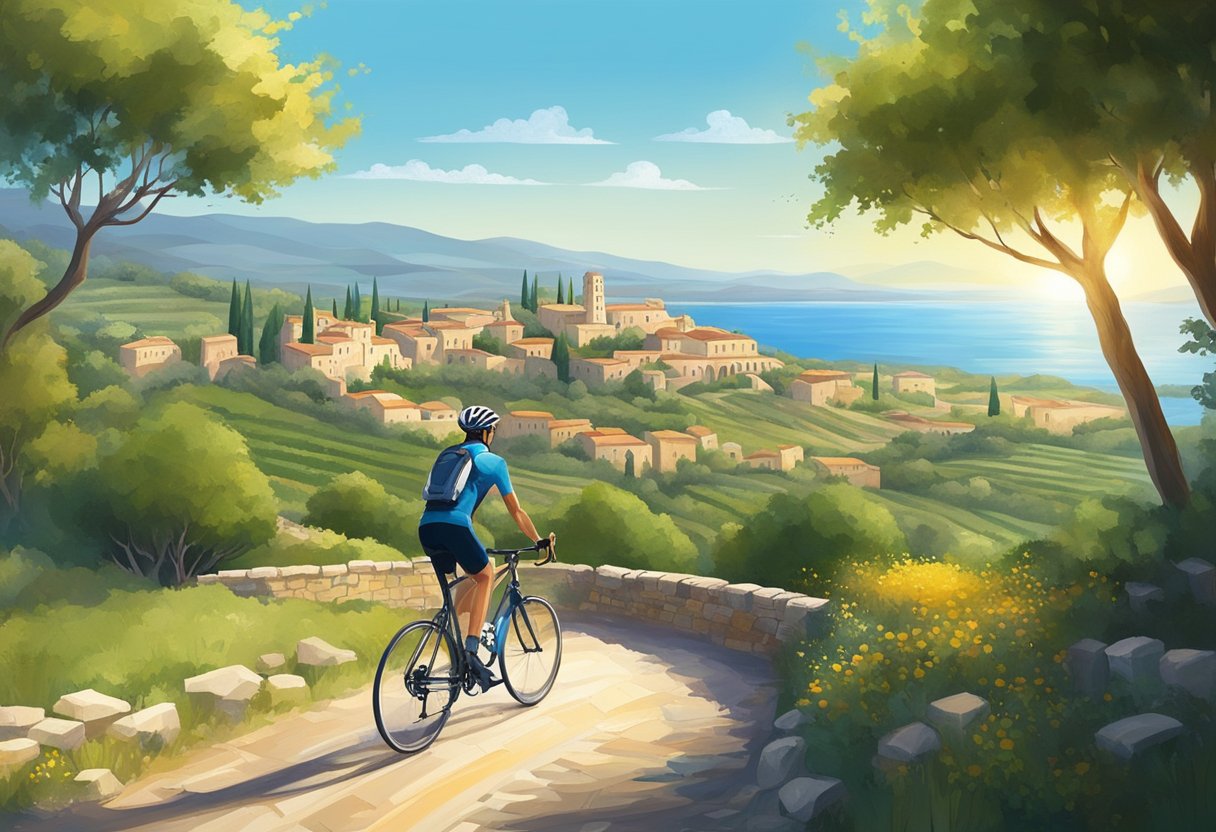
Cycling through the Mediterranean countryside isn’t just an activity for fitness enthusiasts; it’s a journey back in time, pedaling through regions that are steeped in history. The regions encompass lands that once saw ancient Etruscans tread and Renaissance artists flourish, with the paths winding through historical heartlands such as Lucca, Pisa, and southern Tuscany, surrounded by iconic cypress trees and a rich artistic heritage.
Medieval Villages and Ancient Etruscans
The Mediterranean countryside is sprinkled with medieval towns and villages that appear to have stood still in time. For example, Lucca, encircled by Renaissance walls, offers cyclists a chance to explore cobblestone streets and observe centuries-old buildings. Similarly, Pisa presents not just its world-renowned leaning tower, but also a wealth of historical architecture and artifacts from its time as a maritime power. Further south, in the region of southern Tuscany, one experiences the legacy of the Etruscans, an ancient civilization predating the Romans. Here, cyclists can ride through areas dotted with archaeological sites and tombs, providing a tangible connection to Italy’s ancient inhabitants.
The Renaissance Influence on the Routes
The Renaissance, a period marked by a cultural flourish that redefined Western art and architecture, strongly influences the routes across the Mediterranean. The roads and paths often lead cyclists to cities with a rich artistic heritage, like those in southern Tuscany, where the Renaissance left an indelible mark. Cyclists can observe the influence of the Renaissance not just in the art and architecture but in the very layout of the roads that navigate through regions once frequented by some of the most influential artists and thinkers of the time. Moreover, the architectural marvels, such as the trulli—stone huts with conical roofs in the southern regions—complement the landscape, offering a journey that is as much about culture and history as it is about cycling.
Gastronomy and Local Delights on Cycling Tours
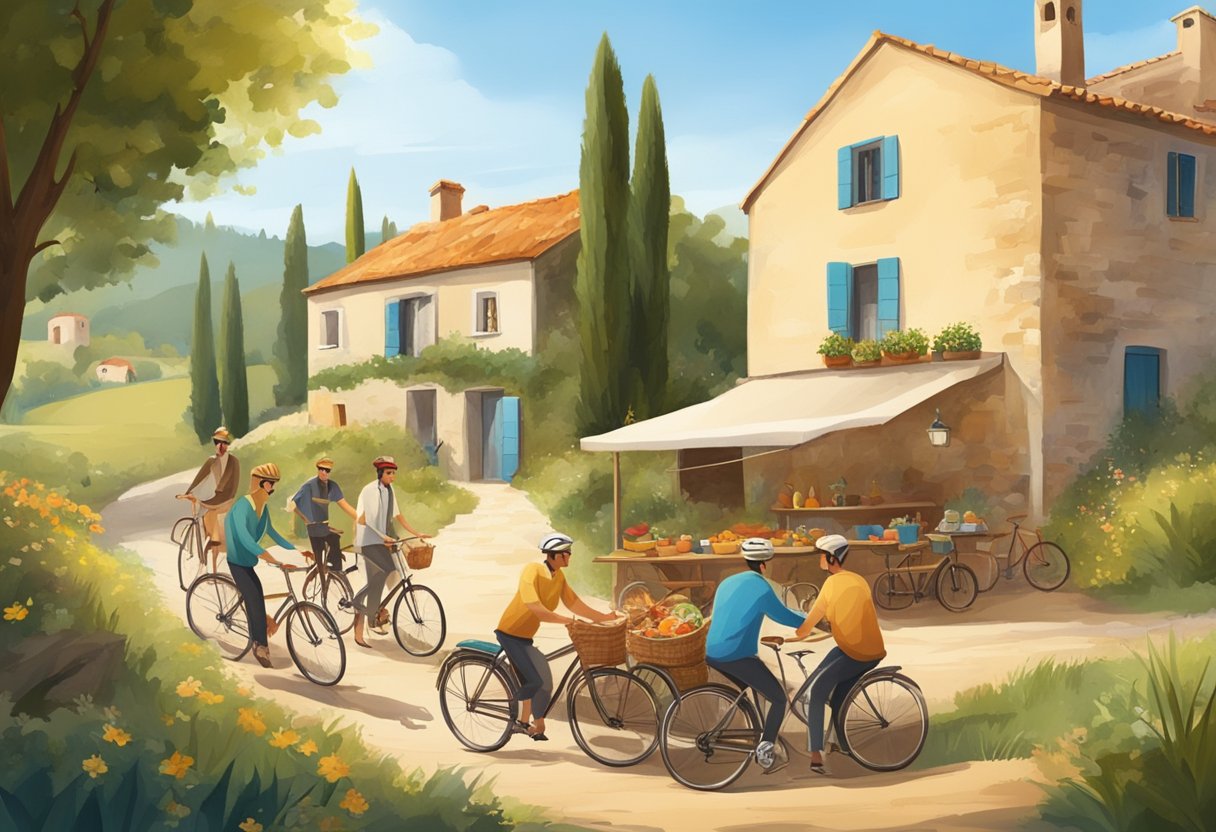
Cycling through the Mediterranean offers more than just breathtaking scenery; it is an immersive experience into the region’s rich culinary tradition. From fresh pasta to exquisite olive oils, cyclists can savor the distinct flavors of each locality.
Tasting the Flavors of the Mediterranean
The Mediterranean diet is renowned for its health benefits and delectable variety. Cyclists touring the region encounter a palette of flavors, often characterized by the extensive use of olive oil, fresh produce, and a range of herbs and spices. Gluten-free options abound, with dishes like risotto and polenta offering delightful alternatives to traditional wheat pasta. In Tuscany, not only can one enjoy the picturesque landscapes, but also taste gluten-free pasta dishes adorned with robust sauces, often featuring wild boar or locally sourced vegetables.
Oenological Excursions in Wine Regions
The Mediterranean is also dotted with prolific wine regions, including the legendary Chianti area in Tuscany, known for its Chianti and Chianti Classico wines. The vineyard tours here not only involve tasting but also learning about the intricate wine-making process. They are a journey through the undulating hills lined with vineyards that contribute to the area’s rich wine culture. In areas like Sicily and the Amalfi coast, travelers encounter wines crafted to complement the regional cuisine, which is infused with the essence of the Mediterranean – all accessible to those following a gluten-free lifestyle.
Accommodations and Authentic Experiences
Travelers seeking a mix of traditional stays and modern conveniences can find a unique blend while cycling through the Mediterranean countryside. Accommodations such as restored farmhouses offer an authentic experience, while cycling-friendly amenities ensure a comfortable and enjoyable journey.
Stays in Traditional Farmhouses and Agritourismos
In the heart of Italy, travelers can stay in traditional farmhouses or agriturismos, which are often remodeled to provide a rustic, yet comfortable lodging experience. These accommodations, nestled in picturesque regions like the green heart of Umbria, offer a true taste of rural life. For example, in regions like Maremma, guests can immerse themselves in the local culture and savor dishes native to the Mediterranean diet, carefully crafted to cater to specific dietary needs, such as gluten-free options.
- Assisi: A stay here offers proximity to cycling routes through sacred sites and rolling hills.
- Bevagna: Encounters with medieval architecture complement the local cuisine.
- Montefalco: Known for Sagrantino wine, it provides a holistic sensory experience.
Cycling-Friendly Amenities and Services
Accommodations throughout these regions are equipped with cycling-friendly amenities and services, ensuring that guests can seamlessly continue their exploration. Many places provide secure bike storage, maintenance tools, and personalized cycling maps that highlight popular routes and trails.
- Facilities: Secure bike storage, repair tools, laundering services for gear
- Services: GPS navigation assistance, rental options for regular or e-bikes, route planning
Guests can expect hospitable services, ranging from guided tours to personalized travel advice, allowing for a well-rounded cycling experience through Italy’s diverse landscape.
Sustainable Cycling and Eco-Friendly Practices
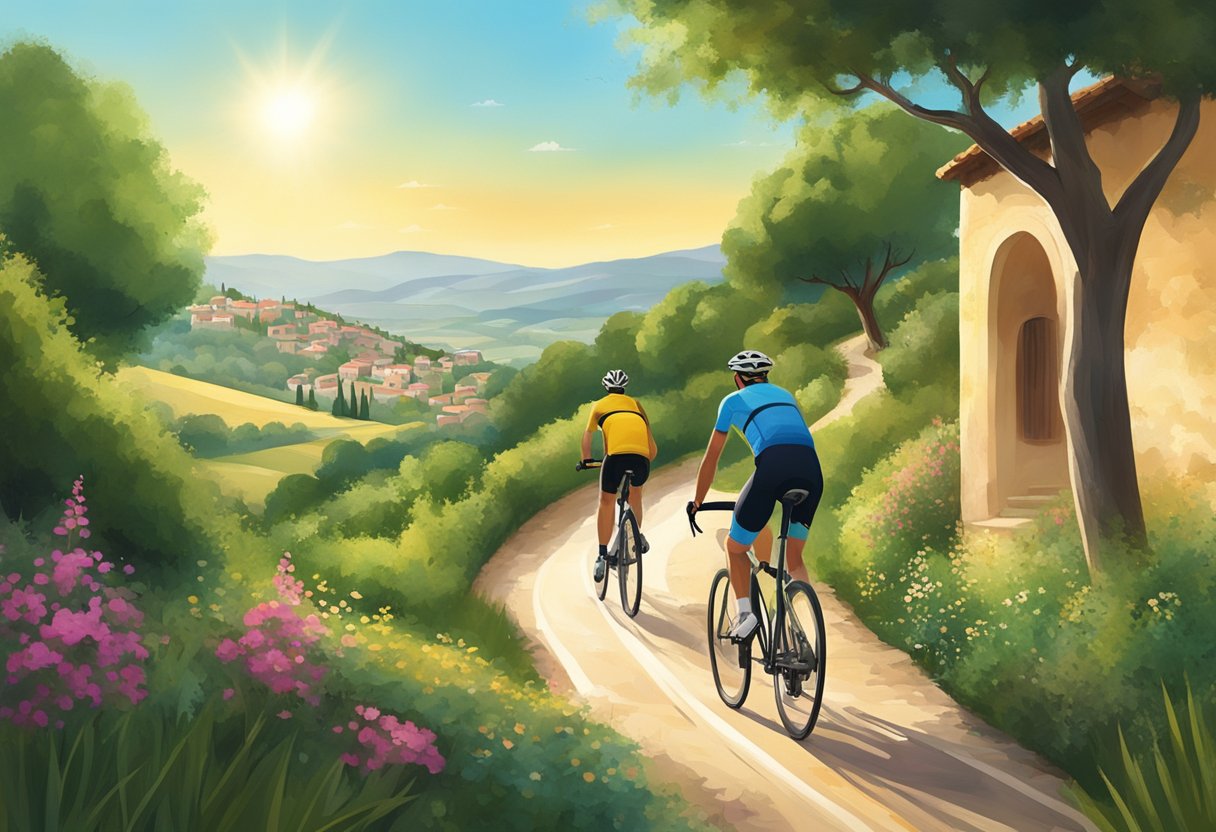
Cycling through the Mediterranean countryside is not only a way to enjoy breathtaking scenery but also an opportunity to engage in eco-friendly travel. This section will discuss the benefits and implementation of sustainable cycling, highlighting its role in promoting green travel.
Promoting Green Travel in the Mediterranean
The Mediterranean region, known for its picturesque landscapes and rich culture, is experiencing a growing trend in sustainable cycling. By choosing bicycles as a mode of transport, individuals are embracing an eco-friendly practice that reduces carbon emissions and promotes environmental conservation. This approach to travel is crucial in preserving the region’s natural beauty and contributing to local economies in an ethical manner.
Sustainable cycling initiatives in the Mediterranean often include the development of dedicated bike lanes and rental services that encourage locals and tourists alike to opt for two wheels instead of four. Furthermore, events and tours are arranged to educate riders on the ecological benefits of cycling, such as reducing traffic congestion and minimizing noise pollution.
It is becoming increasingly common for bicycle manufacturers in the region to produce bikes using environmentally friendly materials and processes. This commitment to sustainability furthers the positive impact that cycling can have on the natural environment.
Incorporating sustainable and eco-friendly practices is not only a win for the planet but also for the health and well-being of the cyclists. The cardiovascular benefits of cycling, coupled with the clean air of the countryside, offer a dual advantage to those looking to maintain a healthy lifestyle while making positive environmental choices.
Conclusion
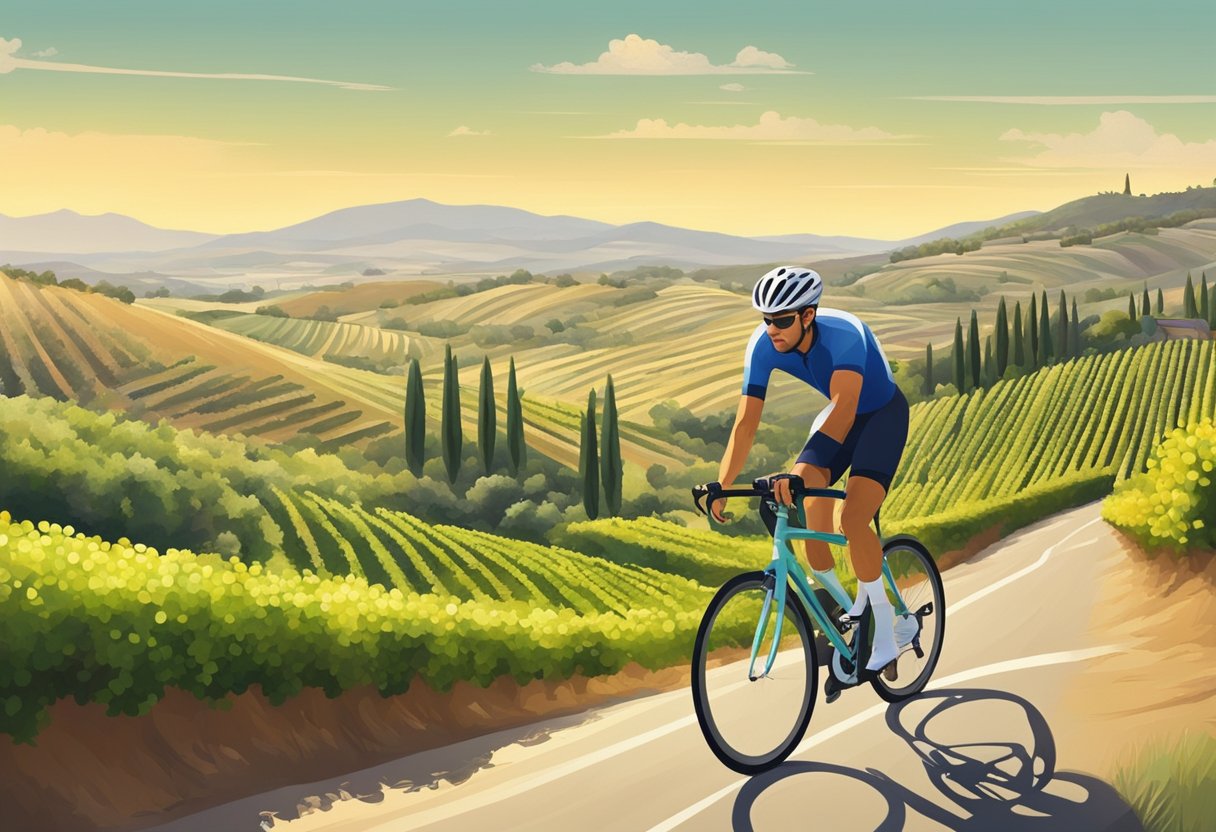
Cycling in Europe offers a unique, immersive experience in the beauty of the Mediterranean landscape. Riders have the opportunity to explore diverse terrains — from the historic villages in Provence to the rugged mountains of Georgia. The activity supports both physical health and a connection with nature’s tranquility.
- Health Benefits: Cycling stands as a heart-healthy activity that aligns well with a gluten-free Mediterranean diet. This combination promotes overall wellness and disease prevention.
- Cultural Exposure: It provides a platform for cyclists to engage with local cultures intimately, enriching their travel experience.
- Environmental Impact: Cyclists contribute to a reduced carbon footprint, fostering sustainable tourism practices.
The Mediterranean region, with its gentle climate and scenic routes, beckons cyclists of all levels. Whether they seek leisure or challenge, there is a route that caters to their preference.
- Routes: From the sun-kissed shores of Greece to the olive groves of Italy, choices abound.
- Infrastructure: Many areas boast well-developed cycling infrastructure, enhancing safety and enjoyment.
As travelers increasingly seek authentic, eco-friendly experiences, cycling through Europe’s countryside complements this trend perfectly. The activity aligns with a responsible lifestyle, integrating physical activity with a diet that is both wholesome and conducive to guarding our planet’s future.
Frequently Asked Questions
When planning a cycling trip through the idyllic countryside of the Mediterranean, travelers often have questions about routes, preparation, and logistics. This section addresses common inquiries with practical advice.
What are the best routes for countryside cycling in the Mediterranean?
The Mediterranean offers a variety of picturesque routes ideal for countryside cycling. The Bike Across Italy tour is a popular choice, spanning from coast to coast through Italy’s heartland. Exploring Tuscany by Bike presents rolling hills and vineyards, while coastal paths in the Mediterranean provide scenic seascapes.
What preparation is needed before embarking on a long-distance bike tour in Europe?
Preparation should include physical conditioning and ensuring one has the proper gear. Research the climate and terrain to select clothing and accessories suitable for the journey. Travelers should also familiarize themselves with local traffic laws and cycling etiquette.
Can you recommend any cycling tours that are female-friendly in the Mediterranean region?
Several cycling tours cater to a diverse range of cyclists, including those specifically designed for female participants. The Bike Across Southern Italy tour offers a welcoming environment focusing on the rich history and gastronomy of regions like Puglia and Campania.
What are the essential items to pack for a Mediterranean cycling trip?
Essential items include a reliable bike, helmet, repair kit, water bottles, and appropriate clothing for variable weather. Sunscreen, sunglasses, and a map or GPS device are also necessary. Packing lightweight and multipurpose items can save space and weight.
How do you navigate accommodation and meals while cycling through rural areas?
Planning ahead is key. Research accommodations that align with the biking itinerary and book in advance if possible. For meals, travelers might opt for local markets that provide fresh, gluten-free options traditional to the Mediterranean diet.
What safety tips should one follow when cycling through less populated areas in the Mediterranean?
It is advisable to wear brightly colored clothing for visibility, carry a first aid kit, and stay hydrated. Cyclists should inform someone of their route and expected return time, and it is wise to carry a charged phone for emergencies.


